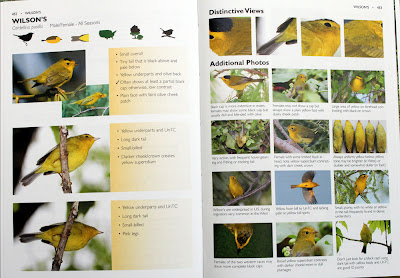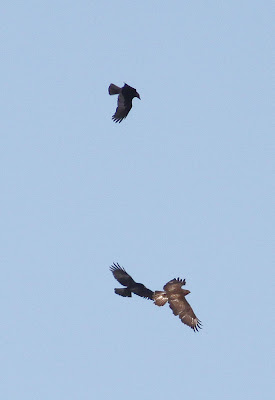Identifying North American warblers was never an easy task. My first trip to Long Point Bird Observatory Canada to coincide with spring migration proved an eye opener in every sense. Luckily I’d spent weeks beforehand swotting the Peterson Guide so had a reasonable handle on species I might encounter as a volunteer bander and field worker. But as a UK birder used to seeing, hearing and instantly recognising the dozen or two warblers of a typical UK Springtime, nothing quite prepares for the diversity of colours, plumages and often similar calls of the warblers of the USA and Canada.
So when a new guide to the continent’s warblers promises to be “groundbreaking” and make warbler identification “easier than ever before”, with the undertaking to help the reader to “effectively learn songs and calls”, I had to take a look.
The book in question is “The Warbler Guide”, by Tom Stephenson and Scott Whittle. The book is not on general release until July 2013 but was kindly sent to me by Princeton University Press in advance and for review on Another Bird Blog.
My first impression was that although The Warbler Guide covers just 56 species it is a hefty book of 550+ pages and at 7 x 9 inches and 2 inches thick would fit more easily in a handy bag or rucksack rather than a jacket pocket. As in the style of many guides nowadays, the aides to identification in The Warbler Guide are based upon photographs, in this case more than 1000 coloured pictures of US and Canadian warblers. The photographs are in the main excellent, many are quite outstanding given the challenges in photographing such an intensively active family of birds.
If someone is looking to open the pages of The Warbler Guide and begin birding, they may be initially disappointed as it is page 138 before the species accounts begin. Any early frustration should be quickly dispelled because while those initial pages add to the bulk of the book, they contain a number of useful innovations which should be studied in depth before using the species accounts. This is especially true for less experienced or starting-out birders who could well find themselves overwhelmed by the magnitude of the task they face in IDing warblers at any time of the year, more so in the fall when less easily identified youngsters appear with moulting adults. This book will be invaluable to that learning curve but will also prove a useful assistant to the more experienced birder who twice a year has to tackle the Everest of warbler ID.
The early part of The Warbler Guide includes sections entitled “What to notice on a warbler”, with illustrative photographs highlighting characteristics like size, shape, behaviour, the face, the body and the undertail. There is a short summary of general ageing and sexing techniques which includes advice on how to use the age/sex codes at the species account pages.
The Warbler Guide - What to notice on a warbler
There follows a lengthy, 38 page section devoted to helping readers ID warblers by listening to them. The authors explain about sonograms, how to listen to warbler songs and also how to learn chip and flight calls. As one who struggles with sonograms I am somewhat biased in thinking that there is no substitute for the old-fashioned way of learning bird calls and song by experience in the field. However I applaud the authors for their very detailed charts and explanations and their willingness to share the latest understanding of this element of birding. Luckily for me and probably for many others, the authors will make a library of warbler songs and sounds available via their web site in time for the book’s publication in July. Furthermore a Smartphone App and an enhanced ebook will follow in spring 2014. The fact that Smartphones Apps are now almost universal raises the question in my mind of whether this section of the book and the two-page sonograms placed at the species accounts will be redundant sooner rather than later, and that reducing the number of pages devoted to this subject could usefully condense the book and achieve a more portable size?
An innovative “Quick Finder” section contains valuable sections on face portraits, side views of the whole bird, 45 degree views, under views, and also separate pages of Eastern and Western undertails. In addition there is a “quick finder” for the geographical East in springtime or the autumn/fall periods, together with a “quick finder” for the West based upon spring only birds. This “Quick Finder” section contains another 20 plus pages devoted to identifying a species through highly descriptive and comparative sonograms of similar sounding species.
Faces - The Warbler Guide
Undertails - The Warbler Guide
The actual species accounts are designed to help a reader narrow down the possibilities, including as they do views from above, the side or below, but also additional photos and “distinctive” views. Where applicable a species is shown in both ”bright” and “drab” versions with bullet pointed features of note, together with additional photographs depicting a comparison of colouration, brightness or hue via a set of skins or a set of partial views. The latter is an often incomplete picture a birder knows only too well. Variations in colour or brightness occur all too often so the direct comparisons offered here are highly useful and extremely valid additions to the information. Another innovation is the use of a set of icons which indicate basic colouration patterns, silhouettes, ranges, and where you're most likely to see the species.
Wilson's Warbler - The Warbler Guide
Here it is worth mentioning how the authors have included colour-coded maps at each ageing and sexing account, the map detailing where a species takes a different migration route in spring and fall/autumn. Each map has a migration-span chart alongside illustrating how Early, Middle and Late waves of warblers can occur in locations during each season. This small but important feature shows a great deal of thought by the authors in helping readers to understand how adult birds, but more especially inexperienced juveniles, can turn up out of place and/or out of time, thus pointing out why a birder should always expect the unexpected.
Cape May Warbler - The Warbler Guide
The alpha-order species accounts take up pages 138 to 525. These pages also include pictures and descriptions of non-warbler species which nonethelesss share shape and size characteristics, ID traps for the unwary which occur with warbler flocks, e.g. bird families like kinglets, verdins, gnatcatchers, vireos and even sparrows.
At the end of the book a set of picture quizzes with answers allow readers the opportunity to test out their new found skills, while more pages illustrate and describe the warblers in flight. For those of a scientific bent there is a taxonomic and evolutionary chart compiled from the latest DNA research and analysis, plus a table of weights and measurements.
North American Warbler Taxonomy - The Warbler Guide
In summary The Warbler Guide is a fine book crammed with photographs, tips, expert advice, innovation and information designed to help identify a unique and beautiful set of birds. As noted at the start of this review my only caveat is that because the book is so comprehensive and chockfull of guidance the actual physical aspect of it may make it rather unwieldy when used in the field.























































.jpg)












